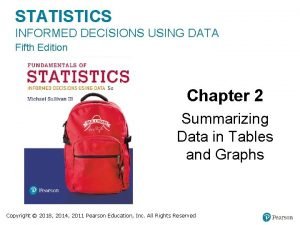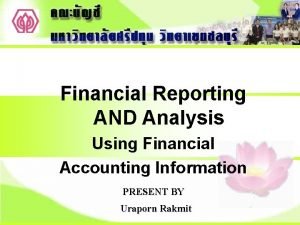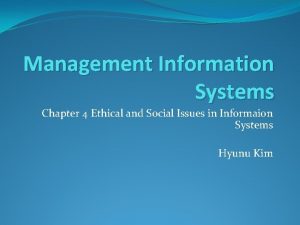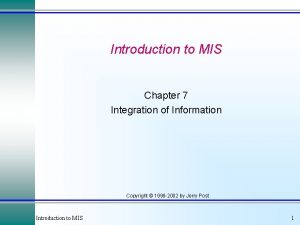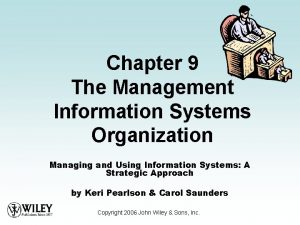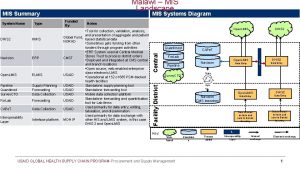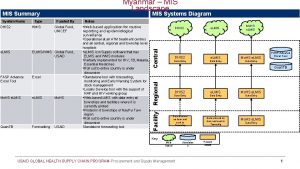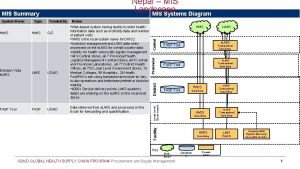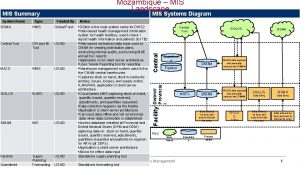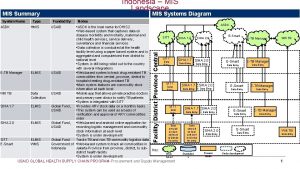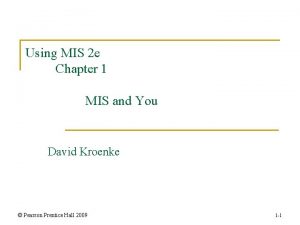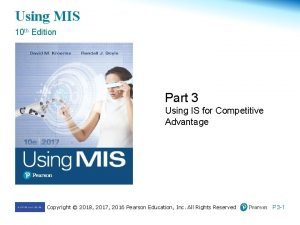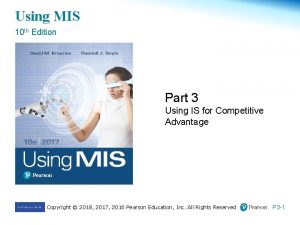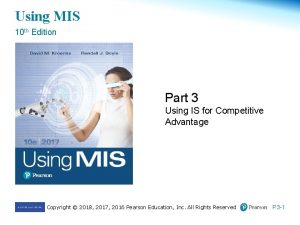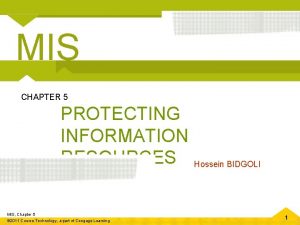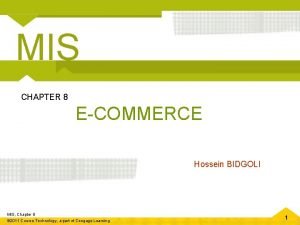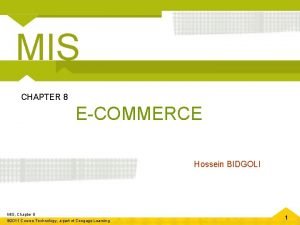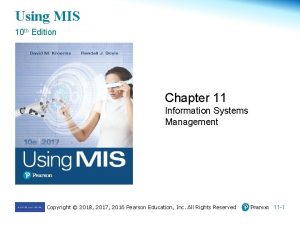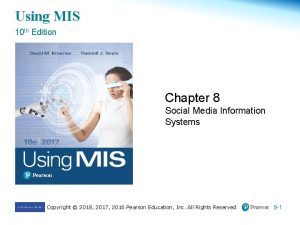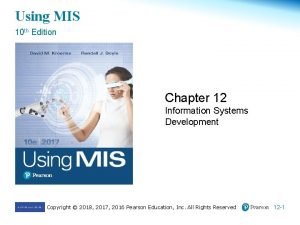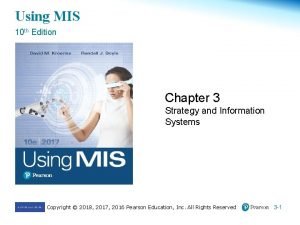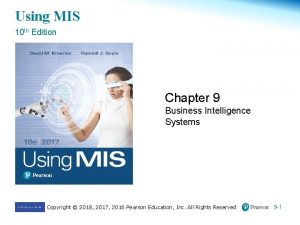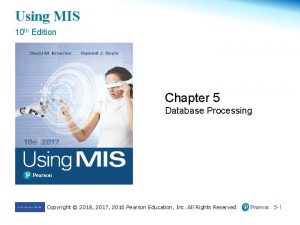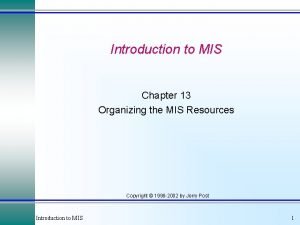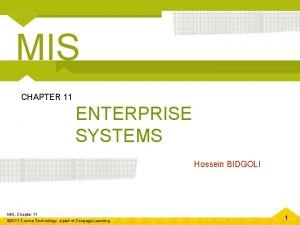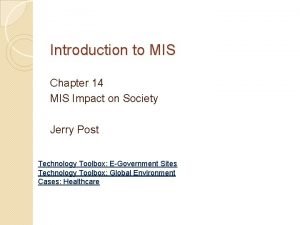Using MIS 10 th Edition Chapter 1 The

























































- Slides: 57

Using MIS 10 th Edition Chapter 1 The Importance of MIS Copyright © 2018, 2017, 2016 Pearson Education, Inc. All Rights Reserved 1 -1

“But Today, They’re Not Enough. ” • Jennifer Lacks Skills Falcon Security Needs: 1. 2. 3. 4. Abstract reasoning skills. Systems Thinking Skills. Collaboration Skills. Experimentation Skills. Copyright © 2018, 2017, 2016 Pearson Education, Inc. All Rights Reserved 1 -2

What Do Employers Want? • Self starter, Don’t wait to be told what to do. • Team worker – Develops ideas with others. – Asks questions. – Pulls more than their own weight. Copyright © 2018, 2017, 2016 Pearson Education, Inc. All Rights Reserved 1 -3

Study Questions Q 1 -1 Why is Introduction to MIS the most important class in the business school? Q 1 -2 How will MIS affect me? Q 1 -3 What is MIS? Q 1 -4 How can you use the five-component model? Q 1 -5 What is information? Q 1 -6 What are necessary data characteristics? Q 1 -7 2027? Copyright © 2018, 2017, 2016 Pearson Education, Inc. All Rights Reserved 1 -4

The Digital Revolution Q 1 -1 Why is Introduction to MIS the most important class in the business school? • Technology fundamentally changing business. • Information Age – Production, distribution, control of information primary economic drivers. • Digital Revolution – From mechanical/analog devices to digital devices. Copyright © 2018, 2017, 2016 Pearson Education, Inc. All Rights Reserved 1 -5

Understanding the Forces Pushing the Evolution of New Digital Devices Q 1 -1 Why is Introduction to MIS the most important class in the business school? • Bell’s Law – New class of computers establishes a new industry each decade. § New platforms, programming environments, industries, networks, and information systems. • Understand how next digital evolution will affect businesses. • What an industry does and how it does it will change. Copyright © 2018, 2017, 2016 Pearson Education, Inc. All Rights Reserved 1 -6

Computer Price/Performance Ratio Historical Trend Q 1 -1 Why is Introduction to MIS the most important class in the business school? Figure 1 -1 Computer Price / Performance Ratio Decreases Copyright © 2018, 2017, 2016 Pearson Education, Inc. All Rights Reserved 1 -7

Metcalfe’s Law Q 1 -1 Why is Introduction to MIS the most important class in the business school? • Network value equal to square of number of users connected to it. (V=U 2) – Google, Amazon, e. Bay exist due to large numbers of Internet users. Figure 1 -2 Increasing Value of Networks Copyright © 2018, 2017, 2016 Pearson Education, Inc. All Rights Reserved 1 -8

Fundamental Forces Changing Technology Q 1 -1 Why is Introduction to MIS the most important class in the business school? Law Meaning Implications Moore’s Law The number of transistors per square inch on an integrated chip doubles every 18 months. Computers are getting exponentially faster. The cost of data processing is approaching zero. Metcalfe’s Law The value of a network is equal to the square of the number of users connected to it. More digital devices are being connected together. The value of digital and social networks is increasing exponentially. Nielsen’s Law Network connection speeds for high-end users will increase by 50 percent per year. Network speed is increasing. Higher speeds enable new products, platforms, and companies. Kryder’s Law The storage density on magnetic disks is increasing at an exponential rate. Storage capacity is increasing exponentially. The cost of storing data is approaching zero. Copyright © 2018, 2017, 2016 Pearson Education, Inc. All Rights Reserved 1 -9

Price of Storage Capacity per GB Q 1 -1 Why is Introduction to MIS the most important class in the business school? Figure 1 -4 Price of Storage Capacity per GB Copyright © 2018, 2017, 2016 Pearson Education, Inc. All Rights Reserved 1 -10

This Is the Most Important Class in the School of Business Because You Will Learn: Q 1 -1 Why is Introduction to MIS the most important class in the business school? • How technology fundamentally changes businesses. • Why executives try to find ways to use new technology to create a sustainable competitive advantage. • Assess, evaluate, apply emerging information technology to business. • Help you attain knowledge needed by future business professionals. Copyright © 2018, 2017, 2016 Pearson Education, Inc. All Rights Reserved 1 -11

Technological Change is Accelerating Q 1 -2 How will MIS affect me? • Bell’s Law – Today’s highly successful business could be bankrupt quickly because technology changed and it didn’t. • Example: Blockbuster – In 2004 Blockbuster had $5. 9 B in revenues – In 2010 Blockbuster filed for bankruptcy – High-speed network connections and streaming video changed the competitive landscape Copyright © 2018, 2017, 2016 Pearson Education, Inc. All Rights Reserved 1 -12

How Can I Attain Job Security? Q 1 -2 How will MIS affect me? • Moore’s Law, Metcalfe’s Law, and Kryder’s Law – Driving data processing, storage, communications costs to essentially zero. • Any routine skill can, and will, be outsourced to lowest bidder. Copyright © 2018, 2017, 2016 Pearson Education, Inc. All Rights Reserved 1 -13

What Skills Will Be Marketable During Your Career? Q 1 -2 How will MIS affect me? • Rapid technological change and increased international competition: – Requires skills and ability to adapt. – Favors people with strong non-routine cognitive skills. – Message: Develop strong non-routine cognitive skills. Copyright © 2018, 2017, 2016 Pearson Education, Inc. All Rights Reserved 1 -14

What Is a Marketable Skill? Q 1 -2 How will MIS affect me? Example Jennifer's Problem at Falcon Security Abstract Reasoning Construct a model or representation. Hesitancy and uncertainty when conceptualizing a method for identifying 3 D printable drone parts. Systems Thinking Model system components and show components’ inputs and outputs relate to one another. Inability to model Falcon Security’s operational needs. Collaboration Develop ideas and plans with others. Unwilling to work with others on work. Provide and receive critical feedback. in-progress. Ability to Experiment Create and test promising new alternatives, consistent with available resources. Skill Fear of failure prohibited discussion of new ideas. Figure 1 -5 Examples of Critical Skills for Nonroutine Cognition Copyright © 2018, 2017, 2016 Pearson Education, Inc. All Rights Reserved 1 -15

How Can Intro to MIS Help You Learn Non -Routine Skills? Q 1 -2 How will MIS affect me? • Abstract Reason – Ability to make and manipulate models. – Learn to use and construct abstract models. – Ch. 1: Five components of an IS model. – Ch. 5: How to create data models. – Ch. 10: How to make process models. Copyright © 2018, 2017, 2016 Pearson Education, Inc. All Rights Reserved 1 -16

How Can Intro to MIS Help You Learn Non -Routine Skills? (cont’d) Q 1 -2 How will MIS affect me? • Systems Thinking – Ability to model system components, connect inputs and outputs among components to reflect structure and dynamics. – Ability to discuss, illustrate, critique systems; compare alternative systems; apply different systems to different situations. Copyright © 2018, 2017, 2016 Pearson Education, Inc. All Rights Reserved 1 -17

How Can Intro to MIS Help You Learn Non -Routine Skills? (cont’d) Q 1 -2 How will MIS affect me? • Collaboration – People working together to achieve a common goal, result, or work product. – Ch. 2 discusses collaboration skills and illustrates several collaboration information systems. Copyright © 2018, 2017, 2016 Pearson Education, Inc. All Rights Reserved 1 -18

How Can Intro to MIS Help You Learn Non -Routine Skills? (cont’d) Q 1 -2 How will MIS affect me? • Ability to Experiment – Make reasoned analysis of an opportunity; develop and evaluate possible solutions. § “I’ve never done this before. ” § “I don’t know how to do it. ” § “But will it work? ” § “Is it too weird for the market? ” • Fear of failure paralyzes many good people and ideas Copyright © 2018, 2017, 2016 Pearson Education, Inc. All Rights Reserved 1 -19

Jobs Q 1 -2 How will MIS affect me? • 69% of college graduates need additional training or education. • 46% working in jobs not requiring their degree, underemployed. • Better success for students with courses related to information systems. • Tradable job – Job not dependent on particular location, can be offshore outsourced. Copyright © 2018, 2017, 2016 Pearson Education, Inc. All Rights Reserved 1 -20

Job Growth By Sector Over the Past Twenty Years Q 1 -2 How will MIS affect me? Figure 1 -6 Growth of Jobs by Sector from 1989 to 2009 Copyright © 2018, 2017, 2016 Pearson Education, Inc. All Rights Reserved 1 -21

BLS Occupational Outlook 2014 -2024 Business Managers Marketing Managers Information Systems Managers Financial Managers Human Resources Managers Sales Managers Computer and Information Technology Computer Network Architects Computer Systems Analysts Database Administrators Information Security Analysts Network and Systems Admin. Software Developers Web Developers Business Occupations Accountants and Auditors Financial Analysts Management Analysts Market Research Analysts Logisticians Human Resources Specialists 2012 Median Pay 2014 Median Pay Job Growth (%) 2014 -24 Job Growth (N) 2014 -24 $ 115, 750 $ 120, 950 $ 109, 740 $ 99, 720 $ 105, 260 $ 91, 000 $ 79, 680 $ 118, 700 $ 87, 170 $ 72, 560 $ 93, 350 $ 62, 500 $ 63, 550 $ 76, 950 $ 78, 600 $ 60, 300 $ 72, 780 $ 55, 640 $ 123, 450 $ 127, 640 $ 115, 320 $ 102, 780 $ 110, 660 $ 98, 430 $ 82, 710 $ 80, 280 $ 88, 890 $ 75, 790 $ 97, 990 $ 63, 490 $ 65, 940 $ 78, 620 $ 80, 880 $ 61, 290 $ 73, 870 $ 57, 420 9% 15% 7% 9% 5% 9% 21% 18% 8% 17% 27% 11% 12% 14% 19% 2% 5% 19, 700 53, 700 37, 700 10, 800 19, 000 12, 700 118, 600 13, 400 14, 800 30, 200 186, 600 39, 500 142, 400 32, 300 103, 400 92, 300 2, 500 22, 000 Figure 1 -7 Bureau of Labor Statistics Occupational Outlook 2014– 2024 Copyright © 2018, 2017, 2016 Pearson Education, Inc. All Rights Reserved 1 -22

Bottom Line of MIS Course Q 1 -2 How will MIS affect me? Most important course in business school because: 1. Gives background needed to assess, evaluate, and apply emerging information systems technology to business. 2. Gives marketable skills by helping you learn abstraction, systems thinking, collaboration, and experimentation. 3. Makes you aware of well-paying, high demand MIS-related jobs. Copyright © 2018, 2017, 2016 Pearson Education, Inc. All Rights Reserved 1 -23

Management Information Systems Q 1 -3 What is MIS? • Key elements 1. Management and use 2. Information systems 3. Strategies • Goal of MIS: § Managing IS to achieve business strategies. Copyright © 2018, 2017, 2016 Pearson Education, Inc. All Rights Reserved 1 -24

Management Information Systems (cont’d) Q 1 -3 What is MIS? • Management and use to: – Develop, maintain, adapt by: § Creating an information system that meets your needs, take an active role in system’s development. Why? § Business professionals using cognitive skills to understand business needs and requirements. Copyright © 2018, 2017, 2016 Pearson Education, Inc. All Rights Reserved 1 -25

Components of an Information System? Q 1 -3 What is MIS? Figure 1 -8 Five Components of an Information System Copyright © 2018, 2017, 2016 Pearson Education, Inc. All Rights Reserved 1 -26

Difference Between IT and IS Q 1 -3 What is MIS? • Information technology (IT) 1. 2. 3. 4. Products Methods Inventions Standards IT – IT drives development of new IS. – IT components = Hardware + Software + Data – IS = IT + Procedures + People Copyright © 2018, 2017, 2016 Pearson Education, Inc. All Rights Reserved People IS Procedures 1 -27

Development and Use of Information Systems Q 1 -3 What is MIS? • Business professionals need to: – Take active role to ensure systems meet their needs. – Understand how IS constructed. – Consider users’ needs during development. – Learn how to use IS. – Remember ancillary requirements (security, backups). Copyright © 2018, 2017, 2016 Pearson Education, Inc. All Rights Reserved 1 -28

Achieving Strategies Q 1 -3 What is MIS? • Information systems exist to help people achieve business strategies. – “What is the purpose of our Facebook page? ” – “What is it going to do for us? ” – “What is our policy for employees’ contributions? ” – “What should we do about critical customer reviews? ” – “Are the costs of maintaining the page sufficiently offset by the benefits? ” Copyright © 2018, 2017, 2016 Pearson Education, Inc. All Rights Reserved 1 -29

The Five-Component Model Q 1 -4 How can you use the five-component model? Copyright © 2018, 2017, 2016 Pearson Education, Inc. All Rights Reserved 1 -30

Characteristics of the Five Components Q 1 -4 How can you use the five-component model? • Most Important Component – YOU! – Your cognitive skills determine quality of your thinking, ability to conceive information from data. – You add value to information and information systems. • Only humans produce information. • All components must work together. Copyright © 2018, 2017, 2016 Pearson Education, Inc. All Rights Reserved 1 -31

Why Is the Difference Between IT and IS Important to You? Q 1 -4 How can you use the five-component model? • Avoid common mistake: Cannot buy an IS. – Can buy, rent, lease hardware, software, and databases, and predesigned procedures. • People execute procedures to employ new IT. • New systems require training, overcoming employee resistance, and managing employees as they use new system. Copyright © 2018, 2017, 2016 Pearson Education, Inc. All Rights Reserved 1 -32

Why Is the Difference Between IT and IS Important to You? (cont’d) Q 1 -4 How can you use the five-component model? • High-tech vs. low-tech information systems. – Consider amount of work being moved from people to computers. • Understanding scope of new information systems. – Assess how big an investment new technology represents. • Components ordered by difficulty and disruption. Copyright © 2018, 2017, 2016 Pearson Education, Inc. All Rights Reserved 1 -33

A is for Alphabet So What? • The Internet has enabled innovation and changed our lives. • Google is one of the largest publicly traded companies in the world with a diverse portfolio of projects. • As of August 10, 2015, it was a subsidiary of an overarching company named Alphabet Inc. • Page and Brin manage the overall strategy, but not daily operations of each company. Copyright © 2018, 2017, 2016 Pearson Education, Inc. All Rights Reserved 1 -34

A is for Alphabet (cont’d) So What? • The company was restructured to: – Retain top talent in a highly competitive industry. – Decrease bureaucratic climate. – Improve internal career trajectories of industry superstars. – Make individual companies more nimble, efficient, and autonomous. Copyright © 2018, 2017, 2016 Pearson Education, Inc. All Rights Reserved 1 -35

Defining Information Q 1 -5 What is information? Definitions vary: 1. Knowledge derived from data. 2. Meaningful context. 3. Processed data, or data processed by summing, ordering, averaging, grouping, comparing, or similar operations. 4. “A difference that makes a difference. ” Copyright © 2018, 2017, 2016 Pearson Education, Inc. All Rights Reserved 1 -36

Amazon. com Stock Price and Net Income Q 1 -5 What is information? Figure 1 -9 Amazon. com Stock Price and Net Income Copyright © 2018, 2017, 2016 Pearson Education, Inc. All Rights Reserved 1 -37

Where Is Information? Q 1 -5 What is information? • Graph is not information. – It’s data people perceive and use to conceive information. • Ability to conceive information determined by cognitive skills. • People perceive different information from same data. • You add value by conceiving information from data. Copyright © 2018, 2017, 2016 Pearson Education, Inc. All Rights Reserved 1 -38

Characteristics of Data Q 1 -6 What are necessary data characteristics? • Accurate • Timely • Relevant –To context –To subject • Just sufficient • Worth its cost Copyright © 2018, 2017, 2016 Pearson Education, Inc. All Rights Reserved 1 -39

Ethics and Professional Responsibility Ethics Guide Figure 1 -3 Measuring growth of units sold using different axis values Copyright © 2018, 2017, 2016 Pearson Education, Inc. All Rights Reserved 1 -40

Ethics and Professional Responsibility (cont’d) Ethics Guide Immanuel Kant • Categorical imperative – One should behave only in a way that one would want the behavior to be a universal law. § Are you willing to publish your behavior to the world? Copyright © 2018, 2017, 2016 Pearson Education, Inc. All Rights Reserved 1 -41

Ethics and Professional Responsibility (cont’d) Ethics Guide • Necessity to act in accordance with categorical imperative. – Perfect duty - behavior that must always be met. – Imperfect duty - a praiseworthy action, but not required. § Giving to charity, developing your business skills and abilities. Copyright © 2018, 2017, 2016 Pearson Education, Inc. All Rights Reserved 1 -42

Imperfect Duty of Business Professionals Ethics Guide: Ethics and Professional Responsibility • Imperfect duties – Cultivating your talent is a professional responsibility. – Obtaining skills necessary to accomplish your job. – Continuing to develop business skills and abilities throughout your career. Copyright © 2018, 2017, 2016 Pearson Education, Inc. All Rights Reserved 1 -43

MIS in 2027 Q 1 -7 2027? • Most computers won’t look like computers. • Smartphones – 1 Gbps network connection, – 1 Exabyte storage, – Teraflop+ processing power, – Connect to any electrical device, – Store/stream every song and movie ever made to any device, – Battery life over a month on a single charge. Copyright © 2018, 2017, 2016 Pearson Education, Inc. All Rights Reserved 1 -44

Technology in 2027 (cont’d) Q 1 -7 2027? • BYOD common. • Comprehensive bio-monitoring devices at home, linked to health care systems. • Widespread use of Google Glass or Microsoft’s Holo. Lens. • More people work at home or wherever. • Knowledge and use of business information systems will be more important, not less. Copyright © 2018, 2017, 2016 Pearson Education, Inc. All Rights Reserved 1 -45

Passwords and Password Etiquette Security Guide • 10+ characters. • Does not contain your user name, real name, or company name. • Does not contain a complete dictionary word in any language. • Different from previous passwords used. • Contains both upper- and lowercase letters, numbers, and special characters (such as ˜ ! @; # $ % ^; &; * ( ) _ +; – =; { } | [ ] : “ ; ’ <; >; ? , . /) Copyright © 2018, 2017, 2016 Pearson Education, Inc. All Rights Reserved 1 -46

Passwords and Password Etiquette (cont’d) Security Guide • Never write down your password. • Never ask someone for their password. • Never give your password to someone. • “do-si-do” move—move away so another person can enter password privately. – Common professional practice. Copyright © 2018, 2017, 2016 Pearson Education, Inc. All Rights Reserved 1 -47

Five-Component Careers Career Guide Hardware Data Procedures People Vendors (Microsoft, Oracle, etc. ) Vendors (Acxiom, Google, etc. ) Vendors (SAP, Infor, Oracle) Recruiters (Robert Half, Lucas Group) Vendors Internal MIS Database administration Security Vendors and internal customer support Customer support Training Development Computer engineering Internal MIS Application programmer Quality test Engineer Data modeler Database design Business process management Process reengineering Training Internal MIS recruiting Management Internal MIS Data administration Project management Technical management Consulting Project management, development, pre- and postsale support Sales & Marketing Support Vendors (IBM, Cisco, etc. ) Software Copyright © 2018, 2017, 2016 Pearson Education, Inc. All Rights Reserved 1 -48

Active Review Q 1 -1 Why is Introduction to MIS the most important class in the business school? Q 1 -2 How will MIS affect me? Q 1 -3 What is MIS? Q 1 -4 How can you use the five-component model? Q 1 -5 What is information? Q 1 -6 What are necessary data characteristics? Q 1 -7 2027? Copyright © 2018, 2017, 2016 Pearson Education, Inc. All Rights Reserved 1 -49

zulily Case Study 1 • What is the business model? – Flash sales to mothers: § Children’s clothes, toys, women’s clothes, accessories, and décor items. – IT provides entertaining shopping experience, name brand goods, unique and difficult-to-find off-brands, at substantial discounts. – 45% of sales over mobile devices. – Curated sales. Copyright © 2018, 2017, 2016 Pearson Education, Inc. All Rights Reserved 1 -50

zulily (cont’d) Case Study 1 Figure 1 -11 zulily Merchandise Variety Courtesy of zulily Inc. Used by permission Copyright © 2018, 2017, 2016 Pearson Education, Inc. All Rights Reserved 1 -51

zulily (cont’d) Case Study 1 2010 2011 2012 2013 2014 Number of active customers (thousands) 157 791 1580 3, 200 4, 900 Revenue (millions) $18 $143 $331 $696 $1, 200 Sales per active customer $117 $180 $218 $245 Figure 1 -13 zulily Performance Courtesy of zulily Inc. Used by permission Copyright © 2018, 2017, 2016 Pearson Education, Inc. All Rights Reserved 1 -52

zulily (cont’d) Case Study 1 • How did they do it? – Buyers identify goods to be sold, negotiate with vendors. – Photographs sample items in-house, write ad copy. – Group items for 3 -day sales events. – After event closes, zulily orders items from vendor, receives, packages, and ships to customers (maintains no inventory). – Vulnerable to vendor’s errors and mistakes. Copyright © 2018, 2017, 2016 Pearson Education, Inc. All Rights Reserved 1 -53

zulily (cont’d) Case Study 1 • Use of Technology at zulily – “Continual innovation through investment in technology is core to our business. ” – Internet, mobile technology compatibility. – Developed a proprietary technology platform to handle. Enormous spikes in web processing demand. – Extensive data collection and analytics capabilities. Copyright © 2018, 2017, 2016 Pearson Education, Inc. All Rights Reserved 1 -54

zulily (cont’d) Case Study 1 • Growth-management problems – Must effectively integrate, develop and motivate a large number of new employees, while maintaining corporate culture. Continue to make substantial investments to expand merchandising and technology personnel. – Need to hire mid-level managers. – Finding and retaining merchandising and technology personnel difficult. Copyright © 2018, 2017, 2016 Pearson Education, Inc. All Rights Reserved 1 -55

zulily (cont’d) Case Study 1 • Lessons Learned – Technology zulily uses not ground breaking. – Developed innovative application of information systems technology. – Applied it to a business opportunity. – Managerial skill to develop that idea. Copyright © 2018, 2017, 2016 Pearson Education, Inc. All Rights Reserved 1 -56

Copyright © 2018, 2017, 2016 Pearson Education, Inc. All Rights Reserved 1 -57
 Mis chapter 6
Mis chapter 6 Report
Report Mis principios y valores proyecto de vida
Mis principios y valores proyecto de vida Los hijos de mis tios son mis
Los hijos de mis tios son mis Mis mai a mis tachwedd
Mis mai a mis tachwedd Mis mai a mis tachwedd
Mis mai a mis tachwedd Mis actos son un reflejo de mis creencias
Mis actos son un reflejo de mis creencias Voyage estimating decision support system
Voyage estimating decision support system Using mis david m kroenke
Using mis david m kroenke Statistics informed decisions using data 5th edition pdf
Statistics informed decisions using data 5th edition pdf Using financial accounting information 10th edition
Using financial accounting information 10th edition Hát kết hợp bộ gõ cơ thể
Hát kết hợp bộ gõ cơ thể Frameset trong html5
Frameset trong html5 Bổ thể
Bổ thể Tỉ lệ cơ thể trẻ em
Tỉ lệ cơ thể trẻ em Voi kéo gỗ như thế nào
Voi kéo gỗ như thế nào Chụp phim tư thế worms-breton
Chụp phim tư thế worms-breton Chúa sống lại
Chúa sống lại Các môn thể thao bắt đầu bằng tiếng đua
Các môn thể thao bắt đầu bằng tiếng đua Thế nào là hệ số cao nhất
Thế nào là hệ số cao nhất Các châu lục và đại dương trên thế giới
Các châu lục và đại dương trên thế giới Công của trọng lực
Công của trọng lực Trời xanh đây là của chúng ta thể thơ
Trời xanh đây là của chúng ta thể thơ Mật thư anh em như thể tay chân
Mật thư anh em như thể tay chân Làm thế nào để 102-1=99
Làm thế nào để 102-1=99 độ dài liên kết
độ dài liên kết Các châu lục và đại dương trên thế giới
Các châu lục và đại dương trên thế giới Thể thơ truyền thống
Thể thơ truyền thống Quá trình desamine hóa có thể tạo ra
Quá trình desamine hóa có thể tạo ra Một số thể thơ truyền thống
Một số thể thơ truyền thống Cái miệng xinh xinh thế chỉ nói điều hay thôi
Cái miệng xinh xinh thế chỉ nói điều hay thôi Vẽ hình chiếu vuông góc của vật thể sau
Vẽ hình chiếu vuông góc của vật thể sau Biện pháp chống mỏi cơ
Biện pháp chống mỏi cơ đặc điểm cơ thể của người tối cổ
đặc điểm cơ thể của người tối cổ Thứ tự các dấu thăng giáng ở hóa biểu
Thứ tự các dấu thăng giáng ở hóa biểu Vẽ hình chiếu đứng bằng cạnh của vật thể
Vẽ hình chiếu đứng bằng cạnh của vật thể Phối cảnh
Phối cảnh Thẻ vin
Thẻ vin đại từ thay thế
đại từ thay thế điện thế nghỉ
điện thế nghỉ Tư thế ngồi viết
Tư thế ngồi viết Diễn thế sinh thái là
Diễn thế sinh thái là Dot
Dot Các số nguyên tố là gì
Các số nguyên tố là gì Tư thế ngồi viết
Tư thế ngồi viết Lời thề hippocrates
Lời thề hippocrates Thiếu nhi thế giới liên hoan
Thiếu nhi thế giới liên hoan ưu thế lai là gì
ưu thế lai là gì Khi nào hổ mẹ dạy hổ con săn mồi
Khi nào hổ mẹ dạy hổ con săn mồi Khi nào hổ mẹ dạy hổ con săn mồi
Khi nào hổ mẹ dạy hổ con săn mồi Hệ hô hấp
Hệ hô hấp Từ ngữ thể hiện lòng nhân hậu
Từ ngữ thể hiện lòng nhân hậu Thế nào là mạng điện lắp đặt kiểu nổi
Thế nào là mạng điện lắp đặt kiểu nổi System collections generic
System collections generic Dtfd switch
Dtfd switch Management information system chapter 4
Management information system chapter 4 Mis report example
Mis report example Mis chapter 9
Mis chapter 9









